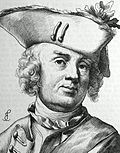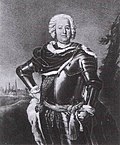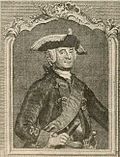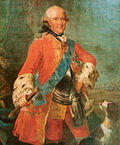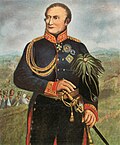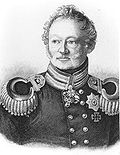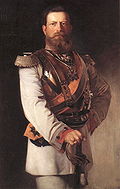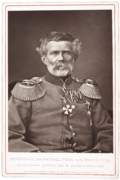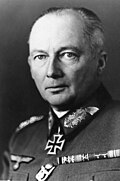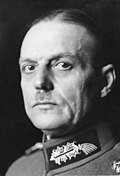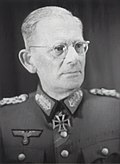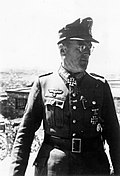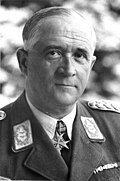List of German field marshals
From Wikipedia, the free encyclopedia
Field marshal (German: Generalfeldmarschall) was usually the highest military rank in various German armed forces. It had existed, under slightly different names, in several German states since 1631.[1] After the unification of Germany it was the highest military rank of the Imperial German Army and later in the Wehrmacht[a][b] until it was abolished in 1945.[2]
The vast majority of the people promoted to field marshal won major battles in wars of their time. Field marshals played a compelling and influential role in military matters, were tax-exempt, members of the nobility, equal to government officials, under constant protection or escort, and had the right to directly report to the royal family.[3] In the Prussian military tradition, which set the tone for the 19th century and the German Empire, field marshals could only be promoted in wartime and the royal family was excluded, both resulting in the creation of the rank of colonel general with the rank of general field marshal (German: Generaloberst mit dem Range eines Generalfeldmarschalls) in 1854. Both restrictions would eventually end with the first royals being promoted during the Franco-Prussian War in 1870, and later honorary promotions to foreign monarchs would follow. Adolf Hitler effectively disregarded the wartime prerequisite by two promotions in 1936 and 1938, though all subsequent promotions were during wartime.
Electorate (1356–1806) and Kingdom of Saxony (1806–1918)
| Name | Date of promotion | Birth and Death | Portrait | Reference |
|---|---|---|---|---|
| Hans Georg von Arnim-Boitzenburg | 21 June 1631 | 1583–1641 |  |
[4] |
| Francis Albert of Saxe-Lauenburg | 24 November 1632 | 1598–1642 |  |
|
| Rudolf Graf von Marzin | 19 October 1638 | 1585–1645 |  |
[5] |
| Ernst Albrecht von Eberstein | 1 January 1666 | 1605–76 |  |
|
| Joachim Rüdiger of Goltz | 28 August 1681 | 1620–88 |  |
[6] |
| Heino Heinrich Graf von Flemming | 8 September 1688 | 1632–1706 |  |
|
| Hans Adam von Schöning | 9 April 1691 | 1641–96 |  |
|
| Jeremias of Chauvet | 10 May 1693 | Unknown–1699 | — |
[7] |
| Heinrich VI Reuß zu Obergreiz | 30 September 1697 | 1649–97 |  |
|
| Adam Heinrich von Steinau | 27 August 1699 | Unknown–1712 | — |
|
| Georg Benedikt von Ogilvy | 3 December 1706 | 1651–1710 |  |
|
| Jacob Heinrich von Flemming | 22 February 1712 | 1667–1728 |  |
|
| Christoph August of Wackerbarth | 17 April 1730 | 1662–1734 |  |
[8] |
| Johann Adolf II, Duke of Saxe-Weissenfels | 26 November 1735 | 1685–1746 | 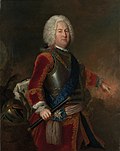 |
[9] |
| Frederick Augustus Rutowsky | 11 January 1749 | 1702–64 |  |
|
| Johann Georg, Chevalier de Saxe | 27 July 1763 | 1704–74 |  |
[10] |
| Frederick of Anhalt-Dessau | 6 January 1775 | 1705–81 |  |
|
| Albert of Saxony | 11 July 1871 | 1828–1902 |  |
[11] |
| Georg of Saxony | 14 June 1888 | 1832–1904 |  |
Brandenburg-Prussia and the Kingdom of Prussia (1701–1870)
German Empire (1871–1918)
Weimar Republic (1918–33)
After the loss of the First World War, Germany was transformed into what became known as the Weimar Republic, which was subject to the terms of the Treaty of Versailles. The military restrictions imposed by the treaty required the reduction of the German Army to 100,000 men,[79] a reduction of the German Navy,[79] and the abolition of the German Air Force.[79] As a result of the new military arrangements, there were no field marshals created during the Weimar Republic.
Nazi Germany (1933–45)
See also
Notes
- The Imperial German Navy and the Kriegsmarine used the rank of Grand Admiral (German: Großadmiral) instead.
- In 1940 Hermann Göring was promoted to Reichsmarschall, a rank higher than that of field marshal and was the only one to hold this rank. This was done so as to make Göring superior to other field marshals and recognize him as the second man in Hitler's Reich.[101]
References
Sources
Wikiwand - on
Seamless Wikipedia browsing. On steroids.










